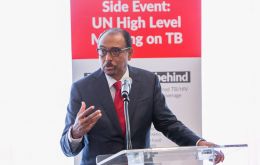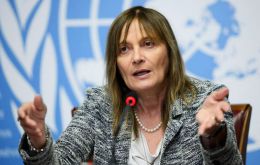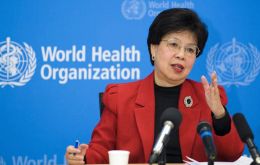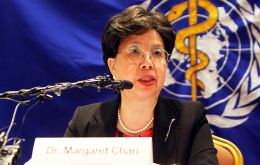MercoPress. South Atlantic News Agency
Tag: tuberculosis
-
Wednesday, April 23rd 2025 - 10:40 UTC
Paraguayan health authorities tackle tuberculosis, HIV and other diseases

Paraguay’s Health Ministry and the Pan American Health Organization (PAHO) have launched a joint technical mission to strengthen the country’s response to HIV and tuberculosis, focusing on eliminating HIV, mother-to-child transmission of HIV, congenital syphilis, hepatitis B, and Chagas disease, as well as managing advanced HIV, TB, and HIV/TB co-infection.
-
Monday, March 24th 2025 - 20:12 UTC
Uruguay reports first autochthonous case of dengue

Uruguayan health authorities Monday confirmed the first autochthonous case of dengue this year. It was a patient in Montevideo, whose appearance triggered a full-scale deployment of epidemiology teams to track down the Aedes aegypti mosquito, the disease's vector. Montevideo City Hall teams also tested neighbors of the affected person in a move to curtail spreading.
-
Monday, March 17th 2025 - 08:54 UTC
WHO: Tuberculosis remains one of the deadliest diseases worldwide

The World Health Organization (WHO) insisted as the March 24 Tuberculosis (TB) Day looms over that the disease remains one of the deadliest infectious maladies globally, causing 1.25 million deaths and 10.8 million cases in 2023, with significant impacts on vulnerable populations, including HIV positive patients.
-
Saturday, October 16th 2021 - 06:57 UTC
Tuberculosis deaths rise for the first time in more than a decade due to the COVID-19 pandemic

The COVID-19 pandemic has reversed years of global progress in tackling tuberculosis (TB) and for the first time in over a decade, TB deaths have increased, according to the World Health Organization’s 2021 Global TB report.
-
Thursday, September 27th 2018 - 08:18 UTC
World leaders commit to bold targets and urgent action to end TB

World leaders meeting at the United Nations (UN) General Assembly have committed to ensure that 40 million people with tuberculosis (TB) receive the care they need by end 2022. They also agreed to provide 30 million people with preventive treatment to protect them from developing TB.
-
Wednesday, March 1st 2017 - 17:11 UTC
WHO stresses urgent need for R&D for drug-resistant tuberculosis

The World Health Organization reaffirms the critical need for research and development (R&D) of new antibiotics to tackle the threat of drug-resistant tuberculosis (TB). “Addressing drug-resistant TB research is a top priority for WHO and for the world,” said Dr Margaret Chan, WHO Director-General. “More than US$ 800 million per year is currently necessary to fund badly needed research into new antibiotics to treat TB.”
-
Monday, October 17th 2016 - 19:02 UTC
TB remains the leading infection killer in the world; global efforts to end the epidemic are falling far short

New data published by the World Health Organization (WHO) in its 2016 Global Tuberculosis (TB) Report show that countries need to move much faster to prevent, detect and treat the disease if they are to meet global targets. Governments have agreed on targets to end the TB epidemic both at the World Health Assembly and at the United Nations General Assembly within the context of the Sustainable Development Goals.
-
Thursday, December 3rd 2015 - 11:33 UTC
Global advance of TB, a disease of poverty and inequality, warns world medical association

Tuberculosis should be treated as a disease of poverty and inequality, the World Medical Association said on Wednesday. Against the background of the global growth of tuberculosis, the WMA is updating its training course for physicians to emphasize the relationship between poverty and TB.
-
Thursday, October 29th 2015 - 14:50 UTC
Tuberculosis mortality nearly halved since 1990

The fight against tuberculosis is paying off, with this year’s death rate nearly half of what it was in 1990. Nevertheless, 1.5 million people died from TB in 2014. Most of these deaths could have been prevented, according to the World Health Organization’s Global Tuberculosis Report 2015, which was released on Wednesday in Washington, DC.
-
Friday, August 22nd 2014 - 23:48 UTC
Don't blame Columbus: TB in the Americas already was present...in seals

The long-held idea that Europeans were the first to bring tuberculosis to the Americas when they arrived in the 15th Century has been thrown into doubt. Instead, a study suggests that the deadly disease was present in the area hundreds of years before Christopher Columbus made landfall.
